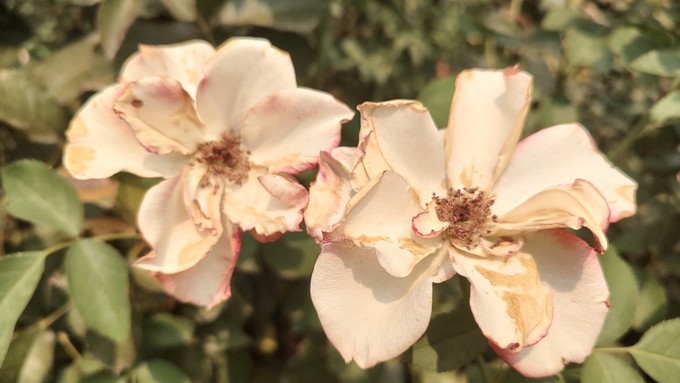
Weather service predicts big cooldown this weekend in Sacramento

These Betty Boop roses, usually with bright red edges, faded immediately in the heat and sun. Instead, their petals are edged in brown. Their stamens dried out quickly, too, depriving bees of food. Debbie Arrington
Smoky skies may bring an end to Sacramento’s string of record-hot days.
“It's a good news/bad news type of Friday here,” tweeted the Sacramento office of the National Weather Service. “Bad: #MosquitoFire smoke is affecting areas downwind of the fire. Good: Smoke may keep afternoon temps a few degrees cooler than originally forecast. Will have to wait & see how it plays out this afternoon during peak heating!”
That original forecast for Downtown Sacramento: 107 degrees.
Added the weather service, if you smell smell, avoid being outdoors.
This smoky day follows a record hot week including the all-time hottest temperature recorded in Sacramento: 116 degrees on Tuesday. (The weather service records go back to 1877.)
Thursday hit 113 – our 43rd triple-digit day this year. That set a new record -- the previous one was 41, set in 1988.
The combination of extreme heat and smoke has stressed plants as well as people. In my own garden, for example, my rose blooms are significantly smaller than usual. Petals are rimmed with brown before they open. Foliage looks sunburned – pale, silvery or toasted around the edges.
But more normal temperatures are on the way: Already in the forecast is a significant cooldown – a 20-degree drop – on Saturday, with clearer skies. “Onshore flow is expected to return tomorrow, so that should push the smoke more to the east/northeast,” tweeted the weather experts.
Weekend temperatures are expected to get no higher than 90 degrees in Sacramento. Afternoon highs in the low 80s are expected by Wednesday. Nighttime temperatures will be 20 degrees cooler, too, dipping into the mid 50s.

This weekend, survey the garden for heat stress. Trim off damaged foliage or toasted blooms. Rinse smoke residue off foliage. And enjoy some much better weather: The long-range September forecast is filled with days in the 80s.
Comments
0 comments have been posted.Sacramento Digs Gardening to your inbox.
Sites We Like
Garden Checklist for week of July 21
Your garden needs you!
* Keep your vegetable garden watered, mulched and weeded. Water before 8 a.m. to reduce the chance of fungal infection and to conserve moisture.
* Feed vegetable plants bone meal, rock phosphate or other fertilizers high in phosphate to stimulate more blooms and fruiting. (But wait until daily high temperatures drop out of the 100s.)
* Don’t let tomatoes wilt or dry out completely. Give tomatoes a deep watering two to three times a week.
* Harvest vegetables promptly to encourage plants to produce more. Squash especially tends to grow rapidly in hot weather. Keep an eye on zucchini.
* Pinch back chrysanthemums for bushy plants and more flowers in September.
* Remove spent flowers from roses, daylilies and other bloomers as they finish flowering.
* Pinch off blooms from basil so the plant will grow more leaves.
* Cut back lavender after flowering to promote a second bloom.
* It's not too late to add a splash of color. Plant petunias, snapdragons, zinnias and marigolds.
* From seed, plant corn, pumpkins, radishes, winter squash and sunflowers.